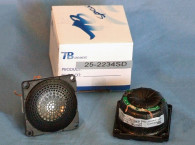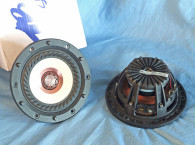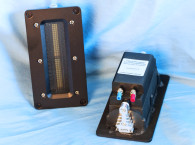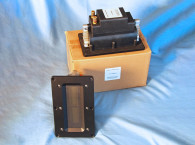
TB Speaker provided the new RT-2202S ribbon transducer (see Photo 1). This device is a closed-back ribbon tweeter with a fairly small 30 mm × 10 mm ribbon diaphragm. Features include a thin aluminum foil diaphragm, an injection-molded face plate, a metal chassis, Nd-Fe-B (neodymium) magnet, a matching transformer, and a pair of gold-plated solderable terminals.
The RT-2202S is a rated 80 W maximum power handling (8 W nominal). It is worthwhile to note that the assembly is not airtight and requires a small enclosure unless the device is mounted in free air.




I began analysis for the RT-2202S by performing a 300-point impedance curve (see Figure 1). As with many ribbon devices, this transducer really doesn’t exhibit a defined resonance. However, the impedance decreases rapidly below 500 Hz, and is nearly a dead short at 10 Hz. This is of no consequence with a high-pass filter in place, but if you are testing the driver, you will need to limit the analyzer sweep bandwidth to approximately 1 kHz to prevent problems with your measurement amplifier.
Next, I mounted the RT-2202S in an enclosure with a 12” × 6” baffle area and measured the on- and off-axis sound pressure level (SPL). I set up the LMS analyzer to produce a 100-point 2.83 V/ 1 m gated sine wave sweep from 1 kHz to 40 kHz. (Normally, I set a 300-Hz-to-40-kHz range, but you need to use a limited bandwidth to protect the measurement amplifier.) I took data in both the horizontal and the vertical planes with sweeps at 0°, 15°, 30°, and 45°. Figure 2 shows the RT-2202S’s on-axis response. The RT-2202S’s frequency response is ±4.45 dB from the recommended 4-kHz crossover frequency to 20 kHz, with useful output out to nearly 30 kHz.
Figure 3 depicts the on- and off-axis frequency response in the horizontal plane, which is excellent above 10 kHz. Since the aspect ratio of the RT-2202S’s aperture is pretty extreme (as are many ribbon transducers), there is substantial directivity in the vertical plane (see Figure 4).


Figure 5 shows the two-sample SPL comparison, indicating that the deviation between the two samples was less than 1 dB from 3 kHz to 10 kHz, with some additional deviation above those frequencies.
I set up the Listen SoundCheck analyzer with the SCM microphone and the SoundConnect preamp/power supply. I used the built-in pink noise generator and the SLM utilities to set the SPL to 94 dB/1 m (6.39 V). I then relocated the 0.25” SCM microphone to 10 cm from the RT-2202S’s faceplate and ran the distortion curves shown in Figure 6. Note that the stimulus was limited to 2 kHz as its lowest frequency, but distortion is most typical above 4 kHz for this driver.
For the RT-2202S’s final measurement, I performed an impulse measurement and imported it into the Listen SoundMap software, windowed out the room reflections, and created the cummulative spectral decay (CSD) plot shown in Figure 7 and the short-time Fourier transform (STFT) shown in Figure 8. For more information, visit www.tb-speaker.com


This article was originally published in Voice Coil, April 2016







